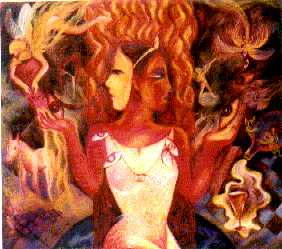“An art centre is long overdue in North East”: Samarendra
--Courtsey : NENA,May 22-June 6 , 1999
It is a long and excruciating road to recognition. Despite the odds faced by upcoming artists in Delhi, this painter from Manipur continues to be optimistic. Th. Samarendra began his career in Calcutta under the guidance of Shri. Shuvaprasanna.
 |
He moved to the Benaras Hindu University in Uttar Pradesh in 1984. Since then, he has participated and has held a number of exhibitions in various parts of India. Many of his works have been collected by various private individuals and organisations in India and abroad. |
At present, Samarendra and his wife Th. Madhuri, a skilled and talented sculptor by profession, continue to execute jobs most dear to their hearts. Madhuri also not only gives moral support but she is equally involved in the works of her husband besides hers. While Samarendra splashes the canvass with a riot of colours, Madhuri sculpts rough marbles, metals and granites into imaginative structures. In an exclusive interview to NENA, Samarendra talks about his works, the trials and tribulations of a North - East artist caught in the cut-throat competitive world of arts in Delhi.
Here are some excerpts from an interview with this painter who composes poems on canvas.
NENA: Can you tell us how did your obsession with painting begin?
Samarendra: Since early days in Bishnupur, Manipur, I
took keen interests in all kinds of art forms. During those days ( late
1960s and early 1970s ), I used to participate in almost all the functions
organised by our school. We had to paint posters and make clay models depending
on the type of functions organised by the school. I think whatever we did
during those days had their impact in shaping my early concepts in paintings
as well as drawings.
 |
I had to leave Manipur in 1982 and joined the College of Visual Arts in Calcutta and learnt fine arts under the guidance of Shri. Shuvaprasanna. There I learnt the basics of fine arts. However, it was in Benaras Hindu University where I started specialising in painting. |
NENA: But you finally landed in Delhi. What brought you here?
Samarendra: It is a long story. My short stint in Calcutta could have changed the entire course of my professional life. I could have moved to Shantiniketan but I did not because of various reasons. In search for new ideas as well as future prospects, I moved to Banaras and later to Delhi. Sustaining fine arts talents in every individual should also be accompanied by material prosperity. Here I mean that if you do not have a stable income, how are you going to paint. You cannot obviously paint in the air. You need mental peace as well as material prosperity to bring out the best in you. And I thought, Delhi would be the ideal place.
NENA: The North-East has a rich cultural heritage. But it has been the performing arts that has hogged the lime light. Why is the state of fine arts put to a position far behind?
Samarendra: It would be wrong to say that the North-East does not have any tradition of fine arts. Assam and Manipur have a very strong tradition of visual arts. You can say that modern contemporary art is not easily understood by the people there. It is the same case with the rest of India. Those engaged in the producing fine arts in the North-East face innumerable problems. Because of the geographical location and all the problems associated with it, it has not been able to highlight the works of those upcoming artists. But taken the prevailing conditions there, a very discouraging trend is on. There are no regional centres of Lalit Kala Akademy in the North-East. Any artist wishing to exhibit his or her works has to come to other centres like Delhi, Calcutta, Lucknow, Bhopal and other art centres. There had been a number of proposals to set up at least one centre in the North-East. Nothing has been done so far. The absence of art patronage by private corporate or industrial houses there also have prevented new talents to flourish. The absence of private art galleries makes it all the more difficult for the artist there. The situation in Guwahati is improving with few well-known artists national repute doing the rescuing act. So many of the sincere and committed artists have moved metropolitan cities to achieve set goals. There they get better exposure and adequate facilities.
NENA: Can you tell us something about your works?
Samarendra: My earlier works are figurative with a strong connotative reflections on the other side of life and the fragile relationship of human kind. Human forms remain unchanging in my works because through them I try to emote the feelings and ideas. The poetic elements in my paintings are derived from urban lifestyles tracing its origin to the beautiful hillside town in Manipur where I grew up. The works also exhibit a taste of nostalgia. My recent works are based on imagination, dreams, folktales on an experimental basis. The whole pictorial expression of these paintings has serious poetic stimulation.
NENA: Can you tell us what are the conditions necessary for an upcoming artist or painter to reach maturity and achieve recognition?
Samarendra: First of all, upcoming artists trying to make it big in Delhi or elsewhere should have a stable income. They can freelance, seek sponsorship and if lucky helps get few commissioned works. A stable income is necessary in a place like Delhi. So many of my contemporaries have taken up either a regular teaching job in a school or joined a commercial art firm. An urban based artist has too may things to worry about. Secondly, a spacious place to stay and store the paintings is a must for any upcoming artist. In Delhi it is really difficult for a young artist to find an affordable living and storing space. Room rents have done up almost double in the last couple of years. One has to maintain good relations with the gallery owners. I know of many talented artists who have left the Capital because they could not get any exposure.
NENA: Many of the art galleries in Delhi owned by private individuals have been accused of selling art rather than promoting it. Would you share your views on this?
Samarendra: In many cases, it has been true. It is not because the owners do not understand fine arts. It is more so because of the interdependence between the needs of the artists and the gallery owners. If the galleries do not sell, how are they going to run them. If the artist's works are not exhibited, how is he going to get exposure. Most of the time the galleries will look for the salability of the art works and not the creative endeavor of the artist. This problem can be also traced to most of the urban buyers who buy works they can understand. Modern interior designing also plays a part here. The buyers generally consider a painting good if the colour elements of the work match with the interiors in their home .
NENA: How would these conditions affect the contemporary art scene in India?
Samarendra: The contemporary modern art scene in India is a mixture of various trends set in the West which include Impressionism, Cubism, Fanaticism, Surrealism, German Expressionism, etc. The works are more of recycling forms and the approach is the same except the original idea of the artist. There are also artists whose works are based on Indian Tantrik art. There are so many talents of all hues. But modern art patronage in India is still in an infantile stage. Most people do not understand what contemporary art is. The majority of the people who at least attempt to understand it belong to the upper class or the upper middle-class category. Hence, you have a series of problems associated with it.